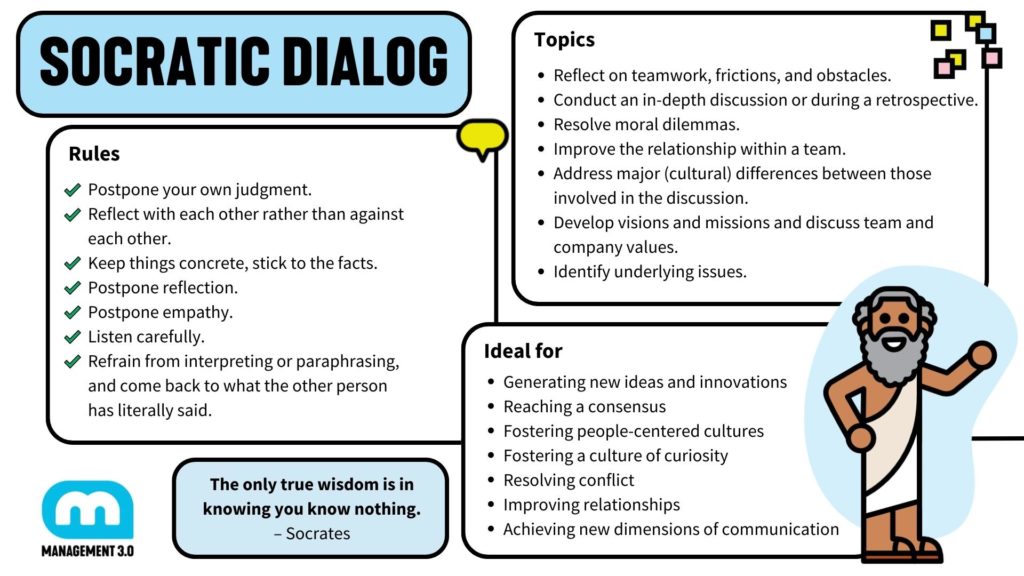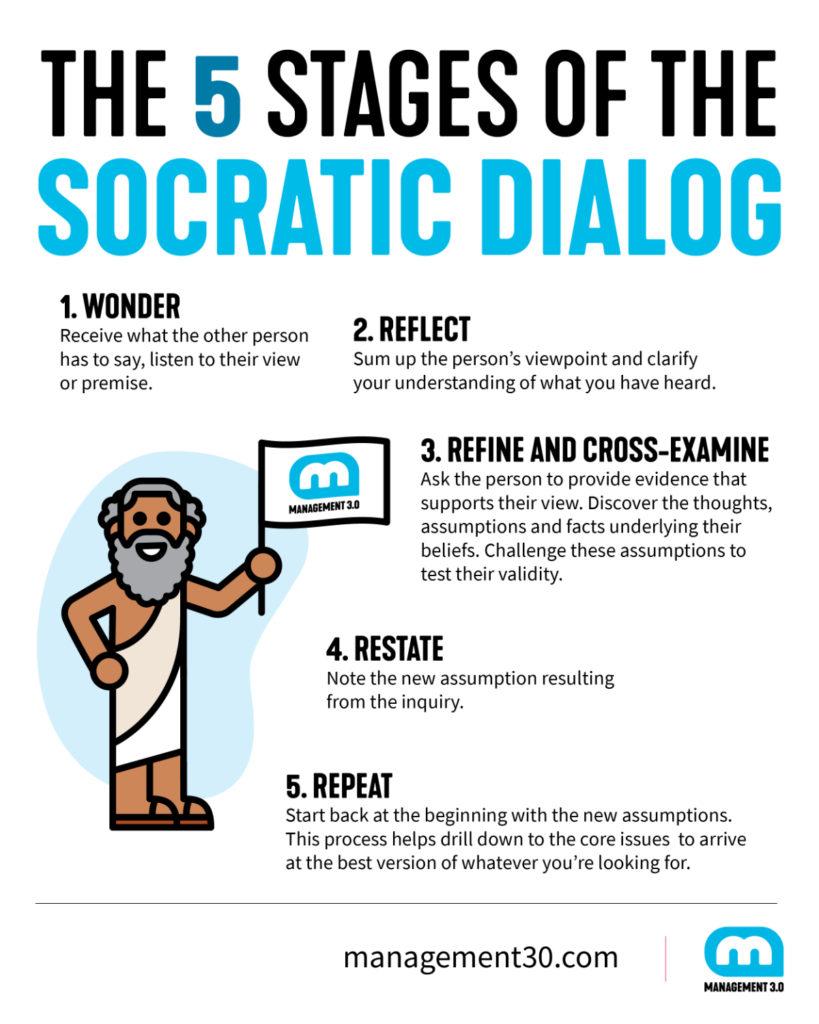By Tanya Akin, Management 3.0 Facilitator and Agile Coach, and Change Practitioner. She specializes in team building, new work and communication, and has been using the Socratic Method with her Agile and non-Agile teams for many years. She loves the method’s solution focus and, having studied philosophy herself, enjoys sharing her love for critical thinking and improving transparency and communication.
- What is the Socratic Method?
- How to conduct a Socratic Dialog?
- What are topics to be discussed via the Socratic Dialog?
- When to use the Socratic Method?
- How can you use the Socratic Dialog as a leader?
The unexamined life is not worth living.
Socrates
Making decisions and reaching consensus is hard and it’s getting harder day by day – or so we may think. We’re confronted with an ever-changing world at a breathtaking pace. The working world is also changing, often emerging from a traditional Management 1.0 command-and-control style and transforming into a more people-centric form of organization and leadership, leading to an entirely new understanding of the roles of employees and managers and the way they communicate and do their job. Instead of managers deciding which goals to pursue and how work is to be done, people have come to realize that really good decisions are made by the experts who are actually doing the work. This brings in a lot of new perspectives and the need to be able to skillfully maneuver in a world filled with a high diversity of thought.
Although this may sound new and revolutionary, it actually is not. In fact, this is something that even the earliest Greek thinkers have been contemplating since the birth of western philosophy. And the Greek philosopher Socrates (ca. 470 BCE to 399 BCE) was a very passionate representative in this respect. He was fascinated by the many perspectives his students had when engaging in heated discussion and debates. Don’t forget, this was when democracy and freedom of thought were born, so the Greeks too were emerging from a ruler-based society to a more people-centered world.
What is the Socratic Method?
According to the philosopher Plato, the Socratic Method was conceived by his mentor, the early Greek philosopher Socrates, in which the facilitator assumes an ignorant position so that students can take the active and more knowledgeable position in the search for an answer.
The only true wisdom is in knowing you know nothing.
Socrates
Actually, Socrates is said to not have seen himself as a teacher, rather he tended to see his role in the process as that of a midwife, as a means to assist others in giving birth to their ideas and sparking curiosity to achieve new insights through dialog and critical inquiry. He wanted to inspire his students to seek real truths through logic instead of defending mere opinions through rhetoric. In our knowledge and innovation-driven society, this has become a critical skill set.
Conducting a Socratic Dialog – Bringing your inner philosopher to life
There are five stages of which the Socratic Dialog is composed:
- Wonder or receive what the other person has to say, listen to their view or premise
- Reflect. Sum up the person’s viewpoint and clarify your understanding of what you have heard.
- Refine and cross-examine. Ask the person to provide evidence that supports their view. Discover the thoughts, assumptions and facts underlying their beliefs. Challenge these assumptions to test their validity. “Why” questions are frequently used in this stage to identify any fallacies in their reasoning.
- Restate the new assumption resulting from the inquiry.
- Repeat. Start back at the beginning with the new assumptions. This iterative process helps drill the premise down to the core issues in an attempt to strip away all fallacies and to arrive at the truth, best answer, most appropriate decision – whatever you happen to be looking for.
The Socratic Method has a number of dialog rules to facilitate the emergence of the conversation. Here are a few of them:
- Postpone your own judgment.
- Reflect with each other rather than against each other.
- Keep things concrete, stick to the facts.
- Postpone reflection.
- Postpone empathy.
- Listen carefully.
- Refrain from interpreting or paraphrasing, and come back to what the other person has literally said.
Socratic Dialog topics
Apart from being a philosophical method of inquiry, the Socratic Method is used in a wide variety of fields such as law, medicine, education and business to achieve a greater understanding of the complexity of our awareness. It is highly useful in practical situations to:
- reflect on teamwork, frictions, and obstacles,
- conduct an in-depth discussion or during a retrospective,
- resolve moral dilemmas,
- improve the relationship within a team,
- address major (cultural) differences between those involved in the discussion,
- develop visions and missions and discuss team and company values,
- identify underlying issues,
- develop new ideas and innovations.
When to use the Socratic Method
- For new ideas and innovations
- To reach a consensus
- To foster people-centered cultures
- To foster a culture of curiosity
- To resolve conflict
- To improve relationships
- To achieve new dimensions of communication

The Socratic Dialog in the business world: How can you use the Socratic Dialog as a leader?
In line with Management 3.0’s take on leadership, leaders who add the Socratic Method to their leadership toolbox take a rigorous departure from Management 1.0 command-and-control worldviews, providing them with the strength and clarity to lead as true servant leaders that deeply trust their employees as experts in their fields by helping them achieve ever-greater knowledge and results.
The Socratic Method helps managers systematically provide an effective guiding light in drawing out principles to actively produce results, achieve innovations and promote listening and discussions at a deeper level. It is an excellent method to establish transparency, identify alternatives, and achieve consensus while avoiding dead-end disputes and controversy.
This method is also gaining great popularity among Agile circles, as it is a simple way of using non-violent language, revealing and unblocking impediments and fostering self-managing teams. As a matter of fact, Agile coaches and scrum masters will very often also refer to themselves as midwives, while they accompany their teams through their journey of constant improvement.
With the Socratic Method, leaders actually find answers together with their employees instead of asking for an answer or telling them what to do. This empowers and motivates your employees, gives them a greater sense of psychological safety and will make you a pretty darn good manager.
Management 3.0 offers several other wonderful tools and practices that can be used in combination with the Socratic Method to help you create a system of motivated and self-organized workers, such as Moving Motivators, Delegation Boards, and Team Decision Cards, to name just a few.
Header Photo by Zach Plank (Unsplash)


